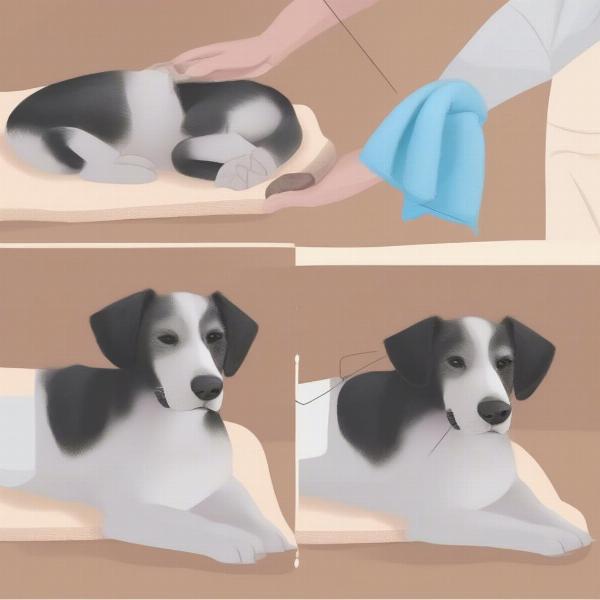A swollen paw in your dog can be alarming, but it’s often a sign of a minor injury. Understanding the common causes, treatments, and when to seek veterinary care can help you ensure your furry friend receives the best possible care. From a simple thorn prick to a more serious infection, this article will guide you through everything you need to know if your dog has a swollen paw.
Common Causes of Swollen Paws in Dogs
Swelling in a dog’s paw can result from various issues, ranging from minor irritations to serious medical conditions. Some common culprits include:
- Injuries: Cuts, punctures from thorns or glass, insect bites or stings, sprains, and fractures can all cause swelling.
- Infections: Bacterial, fungal, or parasitic infections can lead to inflammation and swelling in the paw.
- Allergies: Environmental allergies or food sensitivities can manifest as swollen paws, often accompanied by itching and redness.
- Foreign bodies: Grass seeds, splinters, or small rocks lodged in the paw can cause irritation and swelling.
- Arthritis: This degenerative joint disease can cause pain and swelling in the affected joints, including the paws.
- Tumors: While less common, tumors or cysts can also cause swelling in a dog’s paw.
Treating a Swollen Paw at Home
If the swelling appears minor and your dog isn’t showing signs of severe pain or distress, you can try some home remedies:
- Examine the paw: Carefully check for any visible cuts, thorns, or foreign objects. Remove them gently if possible.
- Clean the area: Wash the paw with warm water and mild soap. Avoid using harsh chemicals or disinfectants.
- Cold compress: Apply a cold pack wrapped in a towel to the swollen area for 10-15 minutes at a time, several times a day. This can help reduce inflammation.
- Rest: Encourage your dog to rest and avoid strenuous activity.
 Applying a Cold Compress to a Dog's Paw
Applying a Cold Compress to a Dog's Paw
When to Seek Veterinary Care
While minor swelling can often be managed at home, it’s crucial to seek veterinary attention if:
- The swelling is severe or doesn’t improve within 24-48 hours.
- Your dog is in significant pain or is limping.
- The paw is hot to the touch or has open wounds.
- There are signs of infection, such as pus or a foul odor.
- Your dog has a fever or is lethargic.
“A timely veterinary visit is essential for accurate diagnosis and treatment of a swollen paw, especially if the cause is unclear or the swelling is persistent,” says Dr. Emily Carter, DVM.
Preventing Swollen Paws
Taking preventative measures can help minimize the risk of your dog experiencing a swollen paw:
- Regular paw checks: Inspect your dog’s paws after walks for any cuts, thorns, or foreign objects.
- Trim nails regularly: Overgrown nails can increase the risk of injury.
- Protect paws in extreme weather: Use paw balm in winter to prevent cracking and irritation from ice and salt. In summer, avoid walking your dog on hot pavement.
- Keep your yard free of hazards: Remove sharp objects, thorns, and poisonous plants.
“Regular paw care is a simple yet effective way to prevent many paw problems, including swelling,” advises Dr. Sarah Miller, DVM.
Conclusion
A swollen paw can be a minor inconvenience or a sign of a more serious issue. By understanding the common causes, implementing appropriate home care, and knowing when to seek professional help, you can keep your dog’s paws healthy and pain-free. Remember, a prompt veterinary visit can often prevent minor problems from escalating into major concerns.
FAQ
- Q: My dog licked his swollen paw, is that bad? A: Licking can introduce bacteria and worsen the condition. Use an Elizabethan collar to prevent licking.
- Q: Can I give my dog human pain medication? A: Never give your dog human medication without consulting a vet. Many human pain relievers are toxic to dogs.
- Q: How long does it take for a swollen paw to heal? A: Healing time varies depending on the cause and severity. Minor injuries may heal within a few days, while more serious conditions can take weeks or even months.
- Q: What are the signs of a paw infection? A: Signs of infection include redness, swelling, heat, pus, a foul odor, and pain.
- Q: How can I protect my dog’s paws in the winter? A: Use paw balm or booties to protect paws from ice, salt, and cold temperatures.
- Q: My dog is limping but his paw doesn’t look swollen, what could be wrong? A: Limping can be caused by other issues besides a swollen paw, such as a muscle strain or joint problem. Consult your veterinarian.
- Q: Can allergies cause swollen paws in dogs? A: Yes, allergies to food or environmental allergens can cause paw swelling, often accompanied by itching and redness.
Related Articles on ILM Dog
ILM Dog is your trusted resource for expert advice on all aspects of dog care, from breed selection and health to training, nutrition, and grooming. We provide practical, reliable information to help dog owners worldwide ensure their furry companions live happy, healthy lives. Whether you’re a new dog owner or a seasoned expert, ILM Dog has the resources you need. Contact us at [email protected] or +44 20-3965-8624 for personalized guidance.